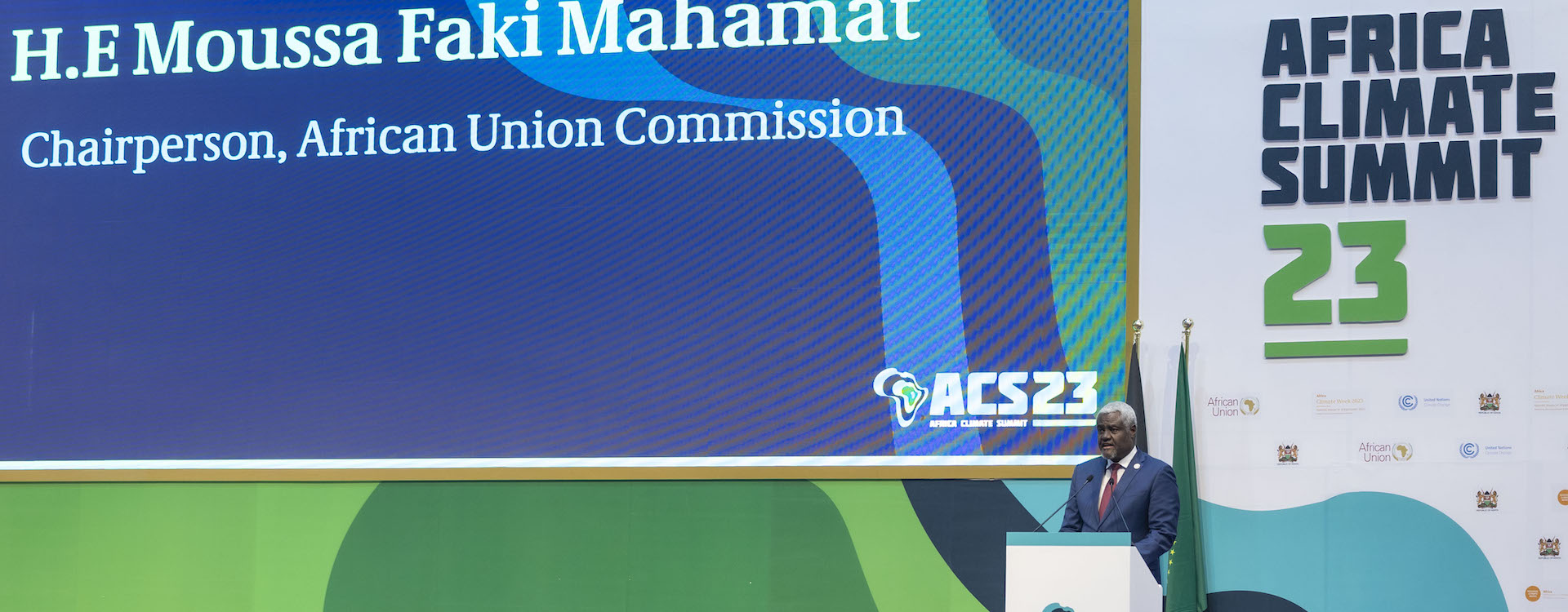Setting a new green growth agenda

African countries must continue the march onto a greener industrial pathway to ensure its most vulnerable are not left behind.
The Africa Climate Summit was held from 4-6 September concurrently with Africa Climate Week from 4-8 September in Kenya. It is no accident that these meetings were held in Nairobi.
President William Ruto, head of the Committee of African Heads of State and Government on Climate Change, and his administration, have adopted an economic agenda centred on embracing a green industrial-led revolution. This squarely addresses the climate crisis, but also importantly several other social, economic, environmental and security goals and objectives that spill over into the shifting geopolitical landscape.
Ruto exercised strong leadership through the events, and urged continental leaders to adopt a green growth model that would allow Africa to position itself as a leading force by unlocking its vast potential. He said Africa was ‘ushering in a new era of international solidarity and multilateral governance to guide the world in climate action and a new green industrial age.’
The conferences underlined the need for Africa, through innovation and technological change, to advance a green growth pathway. This potentially shifts the discussion of Africa’s development towards one where economic growth will increasingly be defined by those who can leapfrog and advance by embracing innovation and technological solutions. This echoes a a view that Africa needs to proceed on a two-track path with some countries forging ahead on governance and green growth more rapidly than others.
Over time this will lead to higher levels of development. A green growth model is one where the state is required to play a central role driving integrated planning processes, while embracing new partnership models and new ways of working across sectors at every level from local to national, regional and global.
Bold visionary leadership from policymakers and other sectors is needed to drive a green revolution
Equally significant is the recognition that development at the expense of the environment is no longer a pathway for a sustainable development future. Ruto called for ‘championing new values to reconcile sustainable development with environmental responsibility through decarbonisation and clean production and advocating inclusion and justice in international governance and development.’
He said African nations were emerging as the ‘new torch bearers of the most impactful climate action as we aspire to chart a new growth agenda.’
To what extent Ruto’s enthusiasm is echoed across the continent is unclear. But the pragmatism is refreshing and timely ahead of this year’s United Nations (UN) Climate Change Conference (COP28) to be held in Dubai. A question may be raised as to the extent to which African countries could and should coalesce around the development of more common positions on the climate transition.
What will a green growth agenda look like, and how will it be driven? A recent UN Environment Programme (UNEP) report, launched during the 19th session of the African Ministerial Conference on the Environment, outlines the enormous potential that exists for Africa to pursue a path towards economic transformation by embracing a green transition.
Significant store is placed in Africa’s private sector, but it won’t be business as usual as there’s an emphasis on businesses adopting a holistic approach anchored in profit, people, planet, prosperity, peace, and partnerships.
This language reflects the UN’s Sustainable Development Goals agenda. As has been highlighted in research conducted by the Institute for Security Studies’ African Futures and Innovation programme, a sustainable future is the only viable way forward for Africa. This will see governments developing ‘robust regulatory frameworks’ and investing in research, innovation, and education. It will also see them promoting public-private partnerships and fostering collaboration across governments, businesses and local communities. This will create the enabling environment in which to foster investment.
African governments don’t sufficiently invest in research and development, which will become key in the years ahead to drive innovation and a technological revolution to economic growth and development. Typically, African governments spend less than 1% of GDP on research and development, where data is available. In fact, economist Mariana Mazzucato asserts that the increasing ‘returns to scale’ that arise from the addition of human capital and technology provide the ‘engines of economic growth.’
Africa can become a pioneer in renewable energy solutions, with plentiful solar, wind, hydro, biomass, and geothermal resources
African government policymakers may need to increasingly consider the importance of investments in technology and human capital to bolster growth, she says. This shift in emphasis that’s needed to chart a way forward and to address climate change and the energy transition will be built on innovation, technology, and the knowledge-based economy.
Central to this transformation are states that must make the investments in knowledge creation mechanisms, provide the high-risk capital heavy infrastructure, provide incentive mechanisms such as tax incentives, as well as shape markets and direct and attract private sector capital.
This implies the need for strong African industrial policy regimes – much like what’s needed to enhance greater beneficiation and value addition approaches to move up the manufacturing ladder. The path that should be followed cannot be carbon-intensive but should rely on breakthroughs in the green hydrogen economy, and other innovations that a country like South Africa is uniquely well placed to drive.
Frameworks of cross-sector exchange and collaboration to contribute resources, ideas, knowledge, skills and expertise to address complex climate issues are essential. The way governments put in place new arrangements and ways of working that attract experts and the scientific community through climate councils and the like will take on new relevance. This will enrich the policy environment that’s vital to lead on this transition.
What are some of the innovations and technologies?
The UNEP report, titled Africa Environment Outlook for Business: Our Environment Our Wealth, sets out an array of opportunities for the private sector to invest in ‘green ventures.’
Transitioning to sustainable agriculture, which contributes approximately 17% to Sub-Saharan Africa’s GDP, is of vital importance for the continent. Embracing new practices such as organic farming, precision agriculture, and agroforestry can enhance productivity while minimising negative impacts on ecosystems and avoiding food insecurity and biodiversity loss.
Transitioning to sustainable agriculture, which contributes approximately 17% to Sub-Saharan Africa’s GDP, is of vital importance for the continent
Digital technologies in agribusiness can unlock US$1 trillion market towards feeding the continent’s growing population, estimated to reach 2.5 billion by 2050. Combatting soil erosion and restoring nature offer business value and can create up to 395 million jobs by 2030, according to the UNEP report.
The blue economy and ecotourism offer opportunities for the private sector. Through research, innovation and managing aquatic ecosystems, the blue economy is projected to generate US$576 billion and 127 million jobs by 2063.
Climate-smart opportunities for a net-zero transition must be addressed as a priority to close Africa’s significant energy deficiencies. Africa can become a pioneer in renewable energy solutions, with plentiful solar, wind, hydro, biomass, and geothermal resources that may contribute to a 6.4% increase in GDP from 2021 to 2050. Ocean renewable energy is a vast untapped resource for Africa, with the potential to generate 100-400% of current global energy demand.
With the right incentives, businesses in the energy-efficiency sector can provide products and services, such as lighting systems, smart buildings, and efficient industrial processes.
Significant reserves of critical minerals like copper, graphite, lithium, molybdenum, nickel, zinc, bauxite, cobalt, manganese, and platinum, mined through sustainable environmental practices, make Africa essential for electric vehicles, solar PV cell technology and wind turbines.
The circular economy offers opportunities to promote sanitation, plastic waste management, recycling infrastructure, sustainable packaging, e-waste collection and refurbishment. This economic model is well positioned to benefit more than 3 000 micro, small and medium enterprises.
The African automotive market dominated by used vehicles offers businesses the opportunity to thrive in vehicle recycling, remanufacturing, battery recycling, shared mobility solutions, repair and maintenance services, circular supply chain management, and training and skills development.
Development at the expense of the environment is no longer a pathway for a sustainable development future
A pipeline of 360 ongoing sustainable infrastructure projects worth $100 billion in several sectors demonstrate the continent’s rich and varied investment opportunities in the transition to net-zero emissions. These include the energy, information, and communications technology, logistics, mining, and construction (as of 2022) sectors. Other projects in the same sectors are valued at $257 billion.
The financing gap for environmentally sound technologies (ESTs) must be addressed. In 2020, only $6.07 billion flowed into Africa for ESTs, while the global exported technology value reached $1.17 trillion. The Climate Policy Initiative estimates that Africa needs an annual average of US$250 billion for climate finance up to 2030. The total annual climate finance mobilised in Africa in 2020 was only US$29.5 billion. Mobilising the full range of financing tools, including both public and private funding across all asset classes, is required to obtain the vast amounts needed.
Multinational development banks are extending their balance sheets and creating new financial instruments to mobilise public and private capital for climate investments.
Significant innovation will be required in financing, especially for low-income countries hoping to draw on renewable energies and lower cost technologies to transition their economies.
Bold visionary leadership from policymakers and other sectors is needed to drive a green revolution. Partnerships must include an array of actors; they cannot depend on the private sector alone.
Lying ahead is COP28, from 30 November to 12 December. African states should position themselves to take advantage of the key topics to continue the march onto a greener industrial pathway through negotiating technology and innovation sharing and stronger financial instruments and products. This will ensure that mechanisms are in place to bring about a just transition and ensure that frontline communities and the most vulnerable are not left behind.
Image: Paul Kagame/Flickr






